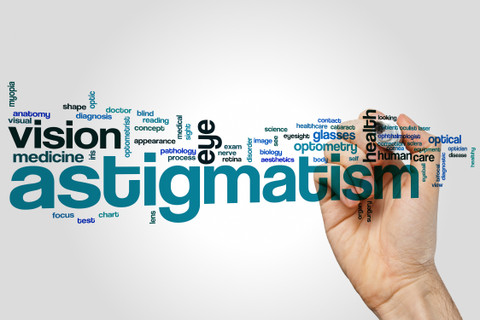Refractive errors are types of vision problems that make seeing clearly difficult. They occur when the irregular shape of the eye prevents images from focusing correctly on the retina. They are pretty common, and many people are unaware their vision could be better. These vision problems can be corrected with contact lenses, glasses, or surgery. This article will guide readers on using contacts for astigmatism – a common refractive error.
What Is Astigmatism?
Astigmatism is a vision disorder caused by an error in the shape of the cornea – the transparent protective outer layer of the eye. A normal eyeball has a perfectly round shape allowing it to bend light evenly. When there is a distortion in this shape, light entering the eye bends more in one direction than the other leading to astigmatism. People with astigmatism have blurred, hazy, or distorted vision. Astigmatism resulting from an irregularly shaped cornea is known as corneal astigmatism, while that resulting from a misshapen lens is known as lenticular astigmatism.
What Causes Astigmatism?
Doctors cannot say for sure what causes astigmatism. Most people with the condition are born with a misshapen cornea or lens. Some others develop astigmatism after an eye disease, injury, or surgical procedure. Sitting too close to the television or reading in low light does not cause astigmatism. Risk factors that predispose people to astigmatism include:
- Blurred, fuzzy, or distorted vision at far and near distances
- Eye strain
- Eye discomfort
- Headaches
- Squinting to see clearly
The symptoms of astigmatism vary among individuals, and some people may not even experience any symptoms even though they are astigmatic.
Astigmatism Vs. Normal Vision
People with astigmatism may see otherwise clear images as blurred, fuzzy, or distorted, depending on the degree of error. Astigmatism can also cause image shadowing, making letters appear as though they are double. The astigmatism vs. normal vision contrast is more pronounced at night. The eyes dilate in the dark to let in more light, making people with uncorrected astigmatism see debilitating glares and halos around streetlights and car headlamps.
What Are Toric Contact Lenses?
Toric contact lenses are designed to correct astigmatism arising from a misshapen cornea. They have a distinct shape that creates different focusing or refractive powers that help people with astigmatism see clearly. Toric contacts have a specific orientation and must stay correctly on the eyes to correct vision. They must be prescribed by an eye doctor who will help the patient choose a perfect fit. Correctly fitting the lenses is especially critical as even the slightest deviation can affect visual acuity.
Toric lenses come with specific features to help them fit the eye:
- A thick zone to prevent them from rotating in the eye and orienting the lenses in a specific way
- A middle axis to keep the line of vision clear
- Lens truncation at the bottom of the lens
Can Astigmatism Be Corrected With Glasses?
Most cases of astigmatism can be corrected with glasses and contact lenses. The type of glasses for astigmatism a person will need depends on the strength of their astigmatism. People who find that their astigmatism impacts their daily activities like reading, driving, or working on a computer may need glasses or contact lenses.
Doctors will examine the eyes to determine whether the patient will benefit from astigmatism glasses or contact lenses. Glasses are generally cheaper, easy to use and provide clearer vision than contacts in astigmatism patients with corneal scarring. Patients with mild astigmatism who do not want glasses can opt for soft contact lenses. RGP and custom-made contact lenses can also be used to correct strong astigmatism.
What Are the Different Types of Contact Lenses for Astigmatism?
There are various types of contact lenses for astigmatism to choose from based on contact lens wearing time, material, and design.
Daily Contact Lenses
Daily contact lenses (dailies) are disposable lenses used once and discarded after removal.
Monthly Contact Lenses
Monthly contact lenses (monthlies) are extended wear lenses a person can wear daily for up to a month.
Weekly Contact Lenses
Weekly contact lenses (weeklies) will be used and disposed of after one or two weeks.
Multi/bifocal Contact Lenses
Multifocal contact lenses are designed to accommodate multiple prescriptions on a single lens, so people with more than one refractive error do not have to juggle wearing devices. Bifocal contacts contain two prescriptions so that wearers can correct two errors with a single lens.
Colored Contacts
Colored contacts are designed to imitate the color of the iris. They may be used for vision correction or cosmetic reasons.
RGP Lenses
RGP (rigid gas permeable) or hard contact lenses are made from firm, silicone-containing compounds that allow gas to pass through the lens material to the eye.
Soft Contact Lenses
Soft contact lenses are made from soft, flexible plastics (hydrogels) that are comfortable and allow oxygen to pass through to the eye.
Hybrid Contact Lenses
Hybrid contact lenses combine the materials from soft and rigid hard contact lenses. They are made with a soft hydrogel “skirt” and a rigid gas permeable center.
Daily Vs. Bi-weekly Vs. Monthly Contacts for Astigmatism
Choosing between daily, bi-weekly, or monthly contacts is a matter of preference and convenience. Daily contacts are used once daily and tossed before bedtime, and users have to wear a fresh pair each day. Daily contacts for astigmatism or other vision problems are healthy as they do not allow the buildup of deposits that may be harmful to the eye. Dailies are comfortable to use, and there is no need to go through the process of cleaning every day. However, daily contact lenses are thinner and tear more easily, so they may not be ideal for people with a sporting or active lifestyle. They are also not eco-friendly due to the need to replace them daily.
Bi-weekly or monthly contacts are used for up to two weeks or a month before replacement. Some of them are approved for overnight wear, so falling asleep in them may not be much of a problem. Weekly and monthly need proper care and storage to prevent eye infections and injury, and some people might find them stressful. However, these contacts are more durable than dailies, so they are suited to people with active lifestyles. They are also eco-friendlier and better for individuals who may have eye allergies.
Colored Contacts for Astigmatism
Because of high production costs, only a few manufacturers make colored contacts for astigmatism. Toric contacts require multiple lens powers in different parts of the lens. The level of astigmatism correction affects the availability of colored contacts, and those with a strong astigmatism prescription will have limited colored contact options. People with a mild prescription may find it easier to get colored toric contacts. Alternatively, the eye doctor may correct mild astigmatism with colored contacts not intended for astigmatism.
RGP Contact Lenses for Astigmatism
Rigid gas permeable contact lenses retain their shape when placed on the eye, replacing the misshapen cornea and focusing light on the cornea correctly. They may not have to be toric to correct mild astigmatism, and people needing a higher amount of correction may need their lenses toric. RGP contact lenses are smaller in diameter, and users often need time to adjust to their lenses.
Multifocal and Bifocal Contacts for Astigmatism
Some people have multiple vision needs and alternate between vision correction devices. They may use regular contacts for their daily activities and put on eyeglasses when it is reading time or use two sets of contact lenses for far and near tasks. Multifocal lenses take away this hassle by having multiple prescriptions on a single lens. Multifocal and bifocal contacts for astigmatism and other vision errors often require a bit of adjustment period, as the eye needs time to differentiate between prescriptions. Bausch and Lomb multifocal contacts for astigmatism and presbyopia offer consistent, stable vision at all distances, even while driving at night.
Hybrid Contact Lenses for Astigmatism
Hybrid contact lenses are designed to provide the benefits of soft and rigid gas permeable lenses. They have a rigid gas permeable center that corrects the error and a soft outer ring that offers crisp vision and comfort. Hybrid contacts are great for people with high corneal astigmatism who want to correct their vision without sacrificing comfort. Wearing and removing hybrid lenses takes some getting used to and may not be ideal for everyone.
Soft Contact Lenses for Astigmatism
Regular soft contact lenses are not commonly prescribed for astigmatism. Individuals with mild prescriptions may use them because of their comfort and ease of use. They don’t provide as clear vision as other lens types for astigmatism, and it is often difficult to get a correct fit, which can further impair vision. However, soft toric contact lenses like Acuvue Oasys correct astigmatism while still offering the comfort and ease of soft contact lenses.
The Top 10 Best Contacts for Astigmatism
Here are 10 of the best contacts for astigmatism:
- Acuvue Oasys
- CooperVision Biofinity Toric
- Bausch and Lomb Ultra
- Clariti 1 Day Toric
- Avaira Vitality Toric
- Air Optix HydraGlyde
- Bausch and Lomb Biotrue ONEday lenses
- Acuvue Vita
- Biotrue ONEday
- CooperVision Proclear Toric
Best Contacts for Astigmatism and Dry Eyes
Contact lenses help people with astigmatism see better and are generally comfortable to wear. However, individuals who experience dry eyes and astigmatism may find that contacts are uncomfortable and do not provide the clear vision they need. Fortunately, newer contact lenses are made from materials designed for people with astigmatism and dry eyes. Some of the best contacts for dry eyes that also correct Astigmatism include:
CooperVision Biofinity Toric
CooperVision Biofinity Toric contact is a monthly disposable contact made with Aquaform technology for improved breathability. Its optimized toric lens geometry also allows decreased rotation through its ballast toric design.
Bausch and Lomb Ultra
Bausch and Lomb Ultra contact lenses come with Moistureseal technology, which helps them retain 95% of moisture for up to 16 hours, making them perfect for people who experience dry eyes.
Acuvue Oasys
Acuvue Oasys comes with eyelid stabilization and Hydraclear technology that provides comfort and stability to people with dry eyes.
Biotrue ONEday for Astigmatism
Biotrue ONEday for Astigmatism contact lenses come with HyperGel material which helps provide better oxygen flow to the cornea and superior moisture retention.
FAQs
Is Having Astigmatism Bad?
Having astigmatism is not bad, and it does not mean you have bad eyes. However, severe astigmatism can cause blurred vision and headaches, affecting your daily activities and negatively impacting your health.
Can Astigmatism Be Cured?
Astigmatism results from an irregular shape of the cornea and can be corrected with contact lenses or glasses. Lenses do not change the shape of the cornea, so they are not a cure. Surgical procedures like LASIK can change the shape of the cornea and cure astigmatism.
Does Astigmatism Get Worse With Age?
Astigmatism does not necessarily worsen with age, but some people report worsening symptoms while others experience decreased astigmatism as they grow older.
Can I Wear Normal Contact Lenses With Astigmatism?
No. You should not wear normal contact lenses with astigmatism. Normal contacts do not cover the cornea entirely, which can decrease your ability to see even further. People with astigmatism should opt for specialized contacts for their condition.
What Does Astigmatism Look Like?
Astigmatism results from the cornea’s irregular shape, which causes uneven refraction of light. Astigmatism manifests as blurred images and double vision in some cases. At night, astigmatism looks like halos and glares around street lights and car headlamps.
What Are the Lines on Contact Lenses for Astigmatism?
The lines on contact lenses for astigmatism are an orientation marking, and the purpose is to identify where the lens is sitting on the eye.
 Save yourself from getting into rush hours and buy your contacts online.
Save yourself from getting into rush hours and buy your contacts online.








